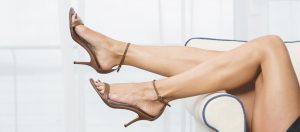By Joyce Vein & Aesthetics Institute
 Spider veins (telangiectasia) are damaged, visible blood vessels just beneath your skin’s surface. They typically look red, blue or purple. They may appear in clusters that resemble spider webs or tree branches. Spider veins can form anywhere, but they usually develop in your legs or face.
Spider veins (telangiectasia) are damaged, visible blood vessels just beneath your skin’s surface. They typically look red, blue or purple. They may appear in clusters that resemble spider webs or tree branches. Spider veins can form anywhere, but they usually develop in your legs or face.
Many of us will eventually encounter vein health issues. It’s usually hereditary, so if your parents or grandparents have or had spider veins, you are more likely to develop them as well. If you become pregnant or have a job or lifestyle that requires standing for long periods of time, this may make them worse, or increase the probability of getting them.
COMMON RISK FACTORS FOR SPIDER VEINS
There are a number of factors that put people at a greater risk of developing spider veins. Some of these include:
. Obesity – extra weight puts additional pressure on the veins.
. Age – though spider veins don’t exist only in older people, the disease progresses with time. This is due to the fact that there is greater wear and tear on vein valves over time. This makes it more difficult for blood to flow properly, and can result in blood pooling.
. Pregnancy – in order to support a baby during pregnancy, blood volume nearly doubles, which leads to enlarged veins and potentially spider veins.
. Genetics – the chances of developing spider veins increases if others in the family suffer from them.
. Sedentary lifestyle – sitting or standing for extended periods of time restricts blood flow and can lead to blood pooling.
. Gender – due to hormonal changes women often experience during pregnancy and menopause, spider veins are more likely to occur in women.
. Hormonal changes – these occur during, pregnancy, and menopause. Taking birth control pills and other medicines containing estrogen progesterone also may contribute to the forming of varicose or spider veins.
. Sun exposure – this can cause spider veins on the cheeks or nose of a fair-skinned person.1
Diagnosis
Diagnosis of spider veins happens with a simple physical examination by a vein specialist. Because spider veins are visible at the surface of your skin, they can simply be diagnosed by a vein specialist during a physical exam. As mentioned above, these veins can appear anywhere on the legs, the face, and the chest. They are purple, blue, pink or red and typically resemble a spider web and can be flat or slightly raised to the touch.
CUTERA LASER TREATMENT FOR SPIDER VEINS
The good news is that we don’t have to live with these ugly spider webs. There are a number of treatment options available for those who’d like to look younger and have healthier looking skin.
The revolutionary Cutera laser treatment is safe and effective in eliminating both small and large varicose veins and spider veins.
The Cutera laser system aims to naturally remove visible spider veins and varicose veins through a cooled handpiece and various energy settings. And the great news is that, because laser energy is used, the procedure is non-invasive and produces no scarring.
How does Cutera work?
After putting gel on the area of your skin to be treated, your doctor will use the Cutera laser to target the spider veins. The laser produces pulses of light energy that will slightly solidify the blood in the vein, thereby destroying the vein. The body will then naturally eliminate the vein, and the blood will flow through nearby veins in the area instead.
The Cutera laser treatment uses a cooling gel to avoid any blistering or damage to the skin. It also prevents any possible pain. Most patients report feeling no discomfort from the treatment.
After the treatment, you can expect some mild redness that will disappear in a matter of hours, or, when treating large areas, some brownish pigment that will disappear within a few weeks. You should let your doctor know if you experience anything that is unusual, unexpected, or painful. Within weeks, you will see your skin become clear, without that unsightly veins that were taking away from your natural beauty and adding years to your appearance.
For more information on this and other state of the art aesthetic treatments, contact Joyce Vein & Aesthetics Institute via email at info@jvai.com or by calling 941.575.0123 to set up a consultation. They are located at 25092 Olympia Avenue, Suite 500 in Punta Gorda.
1. Spider veins – symptoms, causes & treatments (2022) Vein Clinics of America. Available at: https://www.veinclinics.com/conditions/spider-veins/.
Joyce Vein & Aesthetics Institute
941-575-0123
www.jvaiaesthetics.com
25092 Olympia Ave., Suite 500, Punta Gorda, FL 33950








